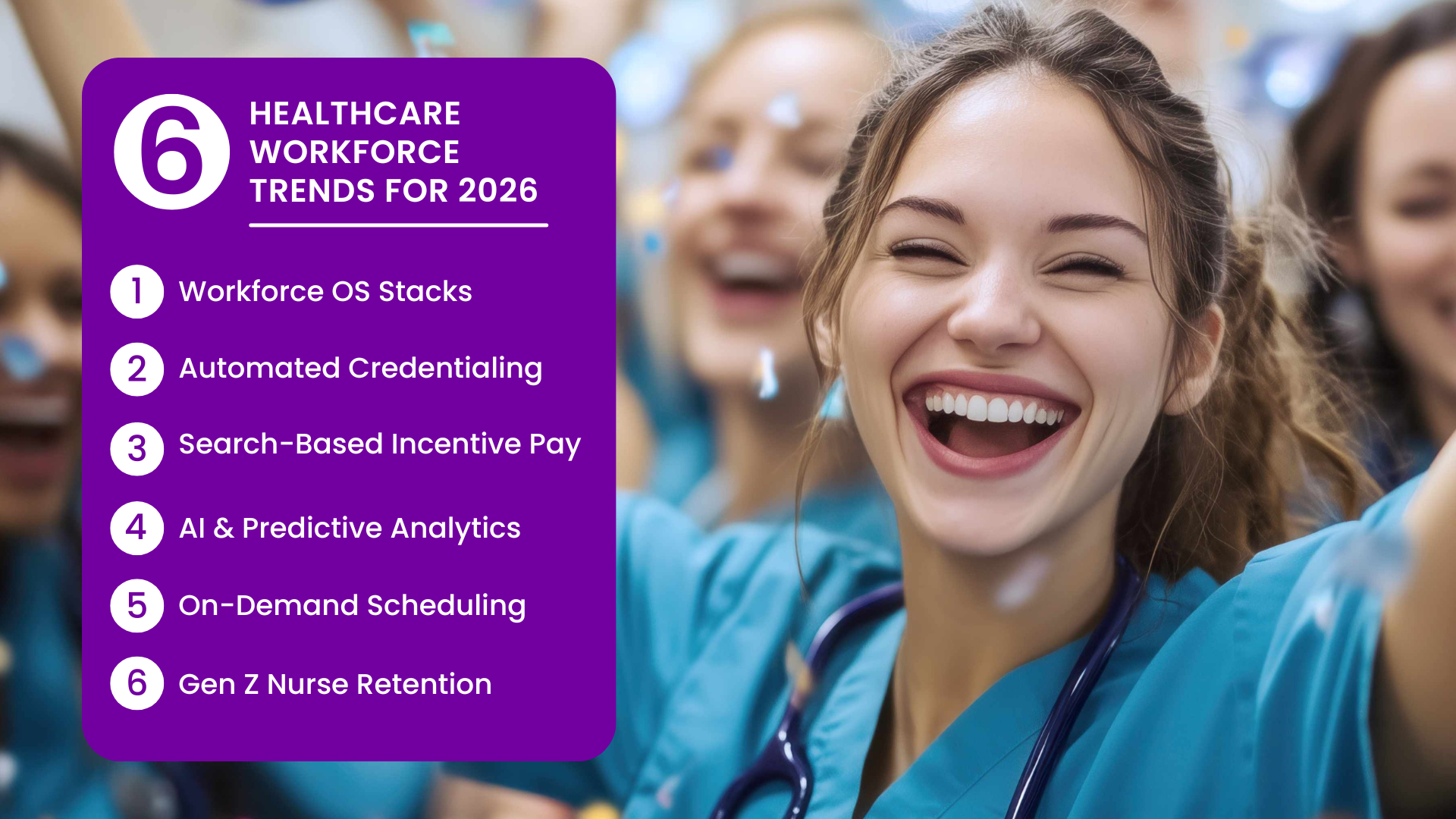2026 Healthcare Workforce Trends That Will Change the Way Hospitals Staff, Pay, and Retain Clinicians

As we enter 2026, healthcare leaders are confronting a hard truth: traditional staffing and scheduling methods no longer meet the demands of modern hospitals. Rising patient volumes, staff burnout, and persistent workforce shortages are pushing systems to their limits, while the next generation of nurses and clinicians expects flexibility, autonomy, and meaningful work.
The solution? Digital, data-driven, and human-centered workforce strategies that empower clinicians and optimize care. In this post, we break down six game-changing trends set to redefine healthcare workforce management in 2026.

1. Healthcare Workforce OS Stack
Healthcare is adopting a smarter approach to managing its workforce. The healthcare workforce OS stack serves as a unified platform that integrates staffing, scheduling, credentialing, compliance, and engagement, eliminating the need for multiple systems, spreadsheets, and endless email chains.
Why it matters:
Provides real-time visibility across the workforce.
Reduces manual work and administrative overhead.
Enables faster, data-driven decision making.
Leading the digital transformation in healthcare staffing, the workforce OS stack is emerging as the central hub for AI-driven scheduling, flexible shift management, and enhanced clinician engagement.
Read More: How Healthcare Workforce OS Stacks Optimize Staffing and Reduce Costs
2. Automated Credential Mapping & Self-Management
Credentialing used to be a paperwork nightmare. Today, clinicians can self-manage their credentials via mobile apps, while automated nurse credentialing systems match licenses and certifications to shifts, roles, and compliance requirements.
Why it matters:
Speeds up onboarding so staff can get to work faster
Reduces administrative burden for HR and managers
Empowers clinicians to manage their own professional readiness
Healthcare credential automation is rapidly evolving into a key driver of workforce efficiency, clinician engagement, and talent retention.
Read More: The Rise of Automated Credential Management in Healthcare
3. Search-Based Incentive Pay
Filling hard-to-staff shifts has never been easier. With search-based incentive pay, nurses and clinicians can view high-demand shifts in real time and earn bonuses for claiming them.
Why it matters:
Fills open shifts faster while reducing costs.
Rewards clinician flexibility and responsiveness.
Boosts clinician engagement and morale.
Healthcare incentive pay is evolving into a dynamic, real-time tool that aligns staffing needs with compensation, helping hospitals cover shifts efficiently while keeping staff motivated.
Read More: Search-Based Incentive Pay in Healthcare
4. AI-Powered Healthcare Workforce Optimization
Artificial intelligence (AI) is revolutionizing the way hospitals manage staffing. With AI-powered workforce optimization, predictive analytics help forecast patient demand, balance workloads, and streamline schedules.
Why it matters:
Anticipates staffing needs before last-minute crises arise.
Reduces clinician burnout with fair workload distribution.
Cuts overtime costs while maintaining quality patient care.
AI in healthcare staffing is becoming the standard tool for smarter, proactive workforce management, helping hospitals move from reactive firefighting to predictive planning.
Read More: How to Use AI and Analytics for Healthcare Workforce Optimization
5. Flexible, On-Demand Scheduling
Rigid schedules are a thing of the past. On-demand healthcare staffing platforms enable nurses and clinicians to choose when and where they work, giving them the flexibility they desire.
Why it matters:
Improves work-life balance and job satisfaction.
Reduces turnover among Millennial and Gen Z clinicians.
Allows staffing to adapt instantly to patient needs.
Flexible, on-demand scheduling is becoming a core strategy for attracting and retaining top talent.
Read More: Flexible Scheduling Strategies for Nurse Managers
6. Gen Z Nurse Retention
As Baby Boomer clinicians retire, Gen Z nurses are stepping into critical roles. Tech-savvy and values-driven, they expect meaningful work supported by modern tools and mentorship.
Why it matters:
Retains the next generation of clinical talent.
Ensures continuity of care as experienced nurses leave.
Encourages knowledge sharing and engagement across teams.
Hospitals that invest in Gen Z-focused workforce programs will stabilize staffing and strengthen engagement, preparing their workforce for 2026 and beyond.
Read More: How Nurse Leaders Can Support Gen Z Nurses and Reduce Turnover
How These 2026 Healthcare Workforce Trends Connect
These six healthcare workforce trends feed into a larger vision. The workforce OS stack serves as the central hub, integrating AI, credential automation, flexible scheduling, incentive pay, and Gen Z engagement into a single, connected ecosystem. Together, they create a workforce that’s smarter, faster, and more human-centered—ready to meet patient needs and thrive in a rapidly changing healthcare environment.
Future-Proof Your Healthcare Workforce
The healthcare workforce is evolving quickly. Hospitals that adopt technology, flexibility, and human-centered strategies will reduce burnout, improve patient care, and retain top talent.
Ready to transform your workforce? Discover how ShiftMed can streamline staffing, boost engagement, and future-proof your hospital for 2026 and beyond. Schedule a free workforce consultation today!